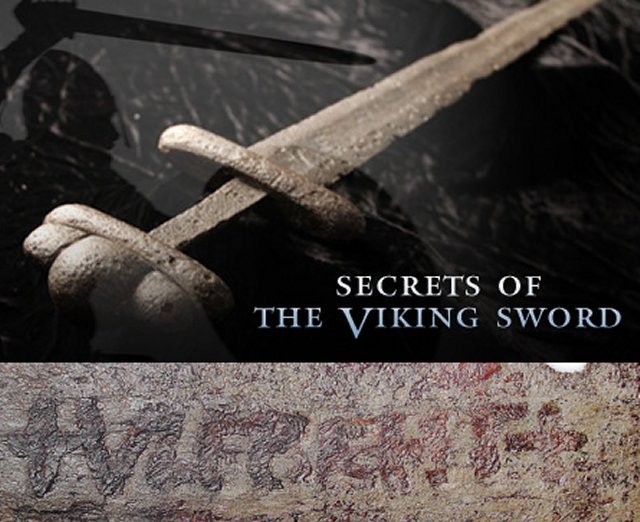Tyrfing And Gram: Two Magical Swords And Hervor’s Death In Norse Mythology
Ellen Lloyd - AncientPages.com - Norse mythology contains wonderful stories about powerful gods and goddesses, creative dwarves, ugly and funny trolls, mysterious places, and strange magical objects.
Swords played a significant role in Norse Sagas and the lives of the Vikings. To give a sword a name was nothing unusual considering that they were expensive, time-consuming to produce, and associated with a distinguished warrior. One of the most famous swords is the Ulfberht sword.
The mysterious Ulfberht sword was a very advanced weapon for thousands of years of its time. Read more
Researchers have so far identified about 100 named swords in Norse mythology. In this article, Ancient Pages will examine two magical and extraordinary swords.
Hervor And Her Magical Sword Tyrfing
In The Saga of Hervör and Heidrek, a legendary Norse saga from the 13th century containing traditions of wars between Goths and Huns from the 4th century and used as a source for Swedish medieval history, we come across the tale of shieldmaiden Hervor, a young woman who always participated in battles.
Hervor possessed a magical sword named Tyrfing. It was an extraordinary weapon invincible to any warrior who fought with it. Tyrfing was always shining brightly, just like the Sun, and every time its edge was uncovered, someone got killed. No living creature could survive even the slightest wound made by the sword.
It was commonly believed that Tyrfing was forged and cursed by the dwarves Dvalinn and Durin for King Svafrlami, one of Odin’s sons. Dwarves were well-known for their outstanding ability to produce remarkable weapons.
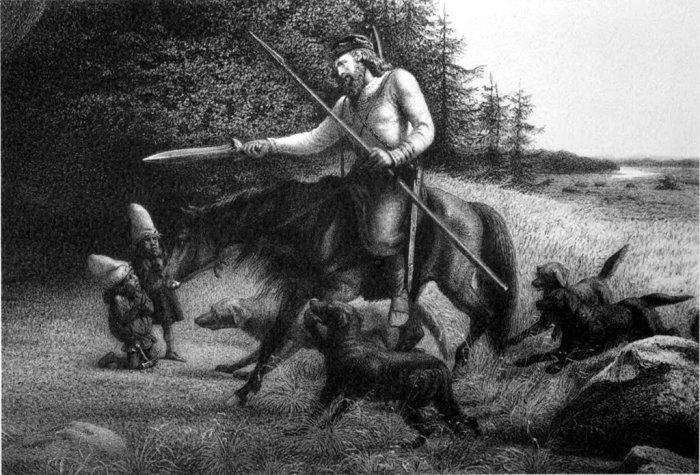 Svafrlami secures the sword Tyrfing. Image credit: Author: Lorenz Frølich (1820–1908). Source - Rydberg, Viktor. 1906. Teutonic Mythology Vol. III.Rydberg, Viktor. 1906
Svafrlami secures the sword Tyrfing. Image credit: Author: Lorenz Frølich (1820–1908). Source - Rydberg, Viktor. 1906. Teutonic Mythology Vol. III.Rydberg, Viktor. 1906
The sword never missed its target and ensured its bearer victory, naturally making it a desirable weapon.
The first owner of Tyrfing was most likely King Svafrlami. One day, he was hunting on his horse and discovered two dwarves near a large stone. He bound them by swinging his sword above them so they could not disappear. The dwarves, named Dvalinn and Durin, asked if they could buy themselves free and undertook to make a magic sword. The sword would neither break nor rust, cut through iron and stone as easily as through cloth, and always give victory.
When Svafrlami acquired the sword, he saw that it was an exquisite and beautiful weapon, and it was named Tyrfing. However, before disappearing into the rock, the dwarves cursed the weapon so that it would never be unsheathed without killing a man, would be the undoing of Svafrlami, and cause three evil deeds.
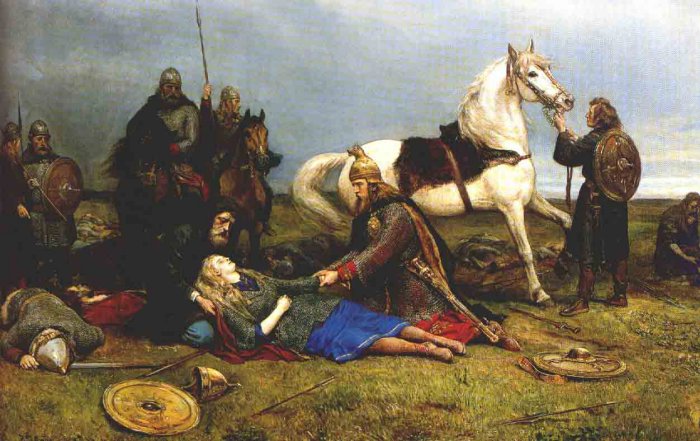 Hervor's death Peter Nicolai Arbo. Hervör was a shieldmaiden in the cycle of the magic sword Tyrfing, presented in̪ the Hervarar saga, of which parts are found in the Poetic Edda. Greatly outnumbered, she died leading the army against the first assault of the Huns in an inheritance conflict between her brothers (Hlöd and Angantýr). The men in this image may represent her foster-father (Ormar) and brother (Angantýr); but as they mourn her in Árheimar (where Ormar flees to Angantýr with a report of the invasion and defeat) exactly this scene does not occur in the saga.
Hervor's death Peter Nicolai Arbo. Hervör was a shieldmaiden in the cycle of the magic sword Tyrfing, presented in̪ the Hervarar saga, of which parts are found in the Poetic Edda. Greatly outnumbered, she died leading the army against the first assault of the Huns in an inheritance conflict between her brothers (Hlöd and Angantýr). The men in this image may represent her foster-father (Ormar) and brother (Angantýr); but as they mourn her in Árheimar (where Ormar flees to Angantýr with a report of the invasion and defeat) exactly this scene does not occur in the saga.
Apparently, Hervor took the Tyrfing from the grave of Angantyr, her father. Angantyr had inherited the sword from his father, the berserker Arngrim.
What happened to the sword when Hervor died remains a mystery.
Gram – The Magical Sword That Killed The Dragon
In the Edda, there is also a tale of another magical sword named Gram which means “enemy.”
The Gram sword is depicted on an old runestone standing on a hill just outside the Swedish city of Eskilstuna.
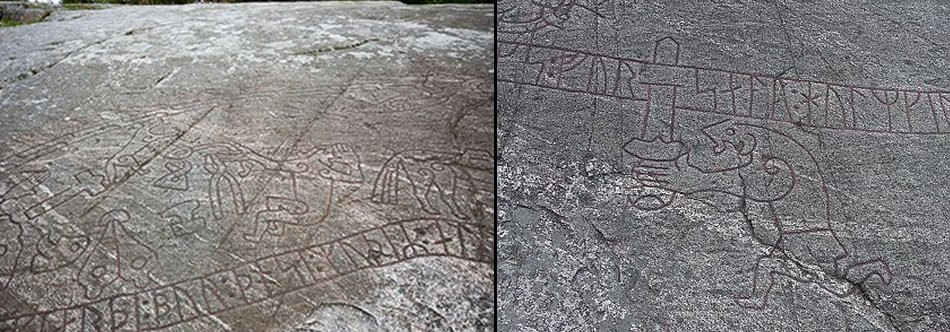 Old runestone In Sweden depicts the battle and death of the dragon.
Old runestone In Sweden depicts the battle and death of the dragon.
According to a Norse legend, a dwarf named Fafner killed his father so he could steal a huge, valuable gold treasure. Fafner was later changed into a dragon. His brother Regin was furious and sought revenge.
Together with a young boy named Sigurd, he located the hiding place of the stolen treasure. Regin forged a strong sword to kill the dragon and reclaim the treasure. He named the sword Gram and killed the dragon with it.
The legend is well-known in Scandinavia, and the event is depicted on a thousand-year-old runestone in Sweden.
Updated on March 17, 2023
Written by - Ellen Lloyd – AncientPages.com
Copyright © AncientPages.com All rights reserved. This material may not be published, broadcast, rewritten or redistributed in whole or part without the express written permission of AncientPages.com
More From Ancient Pages
-
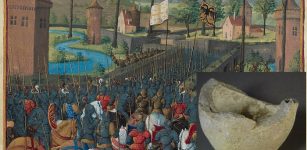 Ancient Hand Grenades: Explosive Weapons In Medieval Jerusalem During Crusades
Archaeology | Apr 26, 2022
Ancient Hand Grenades: Explosive Weapons In Medieval Jerusalem During Crusades
Archaeology | Apr 26, 2022 -
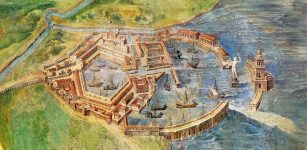 Portus: History Of Ancient Roman Hub Of Commerce – Reconstructed With New Methods
Archaeology | Jul 17, 2019
Portus: History Of Ancient Roman Hub Of Commerce – Reconstructed With New Methods
Archaeology | Jul 17, 2019 -
 Mysterious Etruscan Stone Structures Hidden In The Malano Forest – Evidence Of Ancient Unknown High-Tech Knowledge?
Featured Stories | Dec 19, 2020
Mysterious Etruscan Stone Structures Hidden In The Malano Forest – Evidence Of Ancient Unknown High-Tech Knowledge?
Featured Stories | Dec 19, 2020 -
 1,500-Year-Old Tunnel Tomb With Human Remains And Artifacts Accidentally Unearthed In Japan
Archaeology | Feb 23, 2018
1,500-Year-Old Tunnel Tomb With Human Remains And Artifacts Accidentally Unearthed In Japan
Archaeology | Feb 23, 2018 -
 The Maasai Legend Of Hero Lakalanga And His Ancient Footprints
African Mythology | Jul 12, 2019
The Maasai Legend Of Hero Lakalanga And His Ancient Footprints
African Mythology | Jul 12, 2019 -
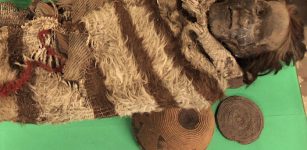 DNA Taken From Cement On Hairs Belonging To Ancient Mummies Shed Light On South American Ancestry
Archaeology | Dec 29, 2021
DNA Taken From Cement On Hairs Belonging To Ancient Mummies Shed Light On South American Ancestry
Archaeology | Dec 29, 2021 -
 Leonardo Da Vinci Has 14 Living Male Descendants – DNA Study Reveals
Archaeology | Jul 7, 2021
Leonardo Da Vinci Has 14 Living Male Descendants – DNA Study Reveals
Archaeology | Jul 7, 2021 -
 5,000-Year-Old Arminghall Henge In Norwich Reveals Some Of Its Secrets
Archaeology | Dec 20, 2022
5,000-Year-Old Arminghall Henge In Norwich Reveals Some Of Its Secrets
Archaeology | Dec 20, 2022 -
 Knowledge Of Secret Ancient Underground Civilization Revealed By Maya Priests
Ancient Mysteries | Nov 1, 2018
Knowledge Of Secret Ancient Underground Civilization Revealed By Maya Priests
Ancient Mysteries | Nov 1, 2018 -
 Rakshasas: Night Wandering Race Of Demons And Warriors Fuelled By Kundalini In Hindu Beliefs
Featured Stories | Oct 8, 2019
Rakshasas: Night Wandering Race Of Demons And Warriors Fuelled By Kundalini In Hindu Beliefs
Featured Stories | Oct 8, 2019 -
 What Did Ancient Mesoamerican Civilizations Know About Unusual Powers Of The Mind?
Ancient Mysteries | Feb 13, 2020
What Did Ancient Mesoamerican Civilizations Know About Unusual Powers Of The Mind?
Ancient Mysteries | Feb 13, 2020 -
 Mictlan – Underworld Realm Of The Dead In Ancient Aztec Beliefs
Aztec Mythology | Jul 2, 2018
Mictlan – Underworld Realm Of The Dead In Ancient Aztec Beliefs
Aztec Mythology | Jul 2, 2018 -
 Obscure History Of Upper Mustang: Prehistoric Paintings Discovered In Nepal
Archaeology | Dec 21, 2017
Obscure History Of Upper Mustang: Prehistoric Paintings Discovered In Nepal
Archaeology | Dec 21, 2017 -
 Discovered 3,700-Year-Old Clay Tablet Shows Babylonians Used Geometry Long Before Pythagoras
Archaeology | Aug 4, 2021
Discovered 3,700-Year-Old Clay Tablet Shows Babylonians Used Geometry Long Before Pythagoras
Archaeology | Aug 4, 2021 -
 The First Australians Ate Giant Eggs Of Huge Flightless Birds That Went Excinct Over 47,000 Years Ago
Archaeology | May 25, 2022
The First Australians Ate Giant Eggs Of Huge Flightless Birds That Went Excinct Over 47,000 Years Ago
Archaeology | May 25, 2022 -
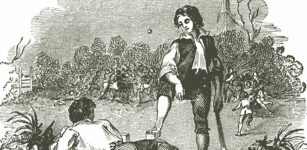 Ancient Irish Games Hurling And Curling Were Forbidden In 1366 By The Englishmen
Ancient History Facts | Jul 23, 2016
Ancient Irish Games Hurling And Curling Were Forbidden In 1366 By The Englishmen
Ancient History Facts | Jul 23, 2016 -
 Stones Of Rajajil – Sophisticated Road Markers Or An Ancient Astronomical Observatory?
Civilizations | May 21, 2017
Stones Of Rajajil – Sophisticated Road Markers Or An Ancient Astronomical Observatory?
Civilizations | May 21, 2017 -
 Ancient Mysteries Of The Amazon Jungle – Survivors Of The Great Flood Or An Atlantean Race Hidden In The Forest? – Part 2
Ancient Mysteries | May 29, 2018
Ancient Mysteries Of The Amazon Jungle – Survivors Of The Great Flood Or An Atlantean Race Hidden In The Forest? – Part 2
Ancient Mysteries | May 29, 2018 -
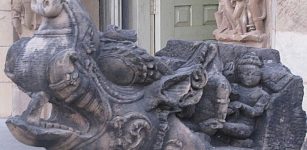 Makara – Legendary Sea-Creature With Many Incarnations In Hindu Mythology
Ancient Symbols | Feb 2, 2020
Makara – Legendary Sea-Creature With Many Incarnations In Hindu Mythology
Ancient Symbols | Feb 2, 2020 -
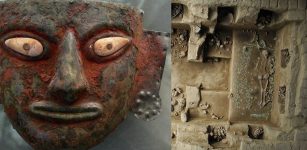 Lady Cao – Moche Queen Who Re-Wrote Ancient History
Civilizations | Jan 12, 2018
Lady Cao – Moche Queen Who Re-Wrote Ancient History
Civilizations | Jan 12, 2018

